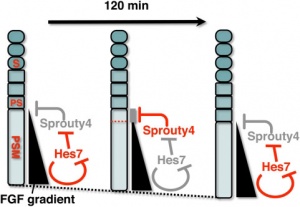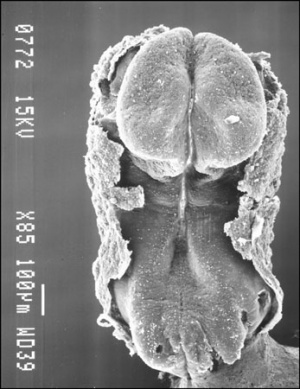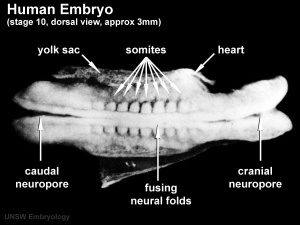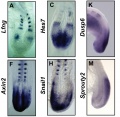Somitogenesis: Difference between revisions
| Line 40: | Line 40: | ||
[[File:Stage11 sem100c.jpg||thumb|stage 11 Embryo]] | [[File:Stage11 sem100c.jpg||thumb|stage 11 Embryo]] | ||
<gallery> | <gallery> | ||
| Line 52: | Line 48: | ||
Image:Somite cartoon5.png|epaxial and hypaxial muscles | Image:Somite cartoon5.png|epaxial and hypaxial muscles | ||
</gallery> | </gallery> | ||
Somite initially forms 2 main components | |||
* ventromedial- sclerotome forms vertebral body and intervertebral disc | |||
* dorsolateral - dermomyotome forms dermis and skeletal muscle | |||
[[File:Somite 001 icon.jpg|90px|link=Development_Animation_-_Somite_Musculoskeletal]] | [[File:Somite 001 icon.jpg|90px|link=Development_Animation_-_Somite_Musculoskeletal]] | ||
Revision as of 17:37, 13 May 2011
Introduction
The term used to describe the process of segmentation of the paraxial mesoderm within the trilaminar embryo body to form pairs of somites, or balls of mesoderm. In humans, the first somite pair appears at day 20 and adds caudally at 1 somite pair/90 minutes until on average 44 pairs eventually form.
A somite is added either side of the notochord (axial mesoderm) to form a somite pair. The segmentation does not occur in the head region, and begins cranially (head end) and extends caudally (tailward) adding a somite pair at regular time intervals. The process is sequential and therefore used to stage the age of many different species embryos based upon the number visible somite pairs.
Some Recent Findings
|
Presomitic Mesoderm
- Within the mesodermal layer either side of the notochord (axial mesoderm) lie the paraxial mesoderm strips.
- Below the unsegmented cranial paraxial mesoderm region the region that will later segment is described as presomitic mesoderm (PSM).
- This PSM is being "patterned" by two two molecular activities described as the "clock" and the "wavefront".
- Many different molecular factors are involved in this patterning effect.
- Hes7, FGF, Sprouty4, Notch
Mesoderm to Somite
Mesoderm means the "middle layer" and it is from this layer that nearly all the bodies connective tissues are derived. In early mesoderm development a number of transient structures will form and then be lost as tissue structure is patterned and organised. Humans are vertebrates, with a "backbone", and the first mesoderm structure we will see form after the notochord will be somites.
- During segmentation the outer cell layer forms an epithelial layer over a still mesenchymal organization of cells at the core.
- The early forming somite has a cavity at its core called a "somitocoel" that later fills with proliferating mesoderm cells.
Somite initially forms 2 main components
- ventromedial- sclerotome forms vertebral body and intervertebral disc
- dorsolateral - dermomyotome forms dermis and skeletal muscle
Additional Images
Embryo Week: Week 1 | Week 2 | Week 3 | Week 4 | Week 5 | Week 6 | Week 7 | Week 8 | Week 9
- Carnegie Stages: 1 | 2 | 3 | 4 | 5 | 6 | 7 | 8 | 9 | 10 | 11 | 12 | 13 | 14 | 15 | 16 | 17 | 18 | 19 | 20 | 21 | 22 | 23 | About Stages | Timeline
Glossary Links
- Glossary: A | B | C | D | E | F | G | H | I | J | K | L | M | N | O | P | Q | R | S | T | U | V | W | X | Y | Z | Numbers | Symbols | Term Link
Cite this page: Hill, M.A. (2024, May 2) Embryology Somitogenesis. Retrieved from https://embryology.med.unsw.edu.au/embryology/index.php/Somitogenesis
- © Dr Mark Hill 2024, UNSW Embryology ISBN: 978 0 7334 2609 4 - UNSW CRICOS Provider Code No. 00098G
- ↑ <pubmed>21368122</pubmed>














